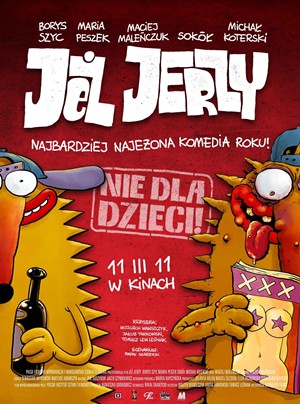Prickly “Hedgehog” Makes Many Points
Sometimes there is a fine line between high art and profanity masquerading as profound. In the Polish film George the Hedgehog (Jeż Jerzy), co-directed by Jakub Tarkowski and Tomasz Lesniak, and which was recently released in the United States, film director Wojtek Wawszczyk and his hedgehog expertly walk that line and explore the relationship between the media, art, and the obscene.
“We are showing a world where pop culture is mixed with high culture, high art,” Wawszczyk said. “I think lots of people are so confused because they are so bombarded with media, they are so surrounded by noisy, colorful pictures; it’s very difficult for a regular viewer to understand what is good and what is not.”
In the film, based on a popular Polish comic book by Rafał Skarzycki and Tomasz Lesniak, George the Hedgehog’s evil clone performs shows which consist of little more than him standing on stage and farting. But because of a massive campaign portraying the flatulent animal as a great artist, the public accepts him as a master.
“I don’t think this is the problem in Poland only,” Wawszczyk said. “We are so surrounded by media and they are so loud, so noisy, it’s very difficult for us to have our own opinion. We are being forced into believing something.”
The farting hedgehog and pointed commentary on the media is hardly the most controversial element of the film. From corrupt politicians to neo-Nazis to sex dolls, George the Hedgehog does not shy away from the unsavory.
In one of the most controversial scenes, a woman explains with a single sentence why she will continue to cheat on her husband, but never divorce him: “I’m a Catholic.” This dialogue is representative of the hypocrisy Wawszczyk sees in some of Polish society.
“Lots of young people in Poland seem very two faced in a way. On one hand, they declare to be Catholic, on the other hand, they live their lives completely against what they declare,” Wawszczyk said.
Wawszczyk and his crew wanted to remain true to the spirit of the original work, no matter how controversial that might make the film. “Once we started making the film production we thought we shouldn’t stop ourselves or make it more polite than it really is. We just wanted it to reflect the edginess and the controversy that are around the graphic novel,” he said.
Their bold approach paid off — because, while the film has generated controversy, it has also brought in rave reviews from critics all over the world.
One unique aspect of the film is that every frame is hand drawn and painted by an intimate team of 14. Wawszczyk sees this as an advantage for Polish animators. While they may lack access to infrastructure and enormous production companies a la Pixar, they can utilize classical painting and sculpture techniques for gorgeous, one-of-a-kind animation.
Wawszczyk has a long history with animation with works ranging from art house shorts and commercials to major Hollywood films like I, Robot.
“I find myself as a person of two different occupations,” Wawszczyk explains. “One is a director and this is more ‘me,’ and this is something I feel very good about. But unfortunately, it’s impossible at the moment to live only as a director. So that’s why I also have another job, which is being an animator, and that’s one of the ways for me to make money, basically. By combining those two ways, I could find over those last years, some sort of a harmony between those two.”
While directing, Wawszczyk relishes the control he has over the work. On the other hand, it means finding money for his projects and resolving problems among his staff.
“When I make my own film, after finishing it I feel completely exhausted, because I just gave some part of myself away, somehow,” Wawszczyk said. “In a way, it’s like stripping naked.”
Animating for a production company or commercial employer allows Wawszczyk a refreshing rest between more creative projects.
When he’s not animating or directing, Wawszczyk is writing and drawing his own graphic novel, a fairytale involving a foundry, an accident, and a human light bulb. The story is finished, but Wawszczyk still has about 400 pages left to draw.
Wawszczyk is passionate about all of his works and is glad that George the Hedgehog reached a broader audience than some of his previous films. But Wawszczyk hopes for even more.
“If it’s possible to have it shown somewhere, I’m very open to it,” Wawszczyk said. “So if anybody is interested in contacting me and having a screening of George the Hedgehog, I’m in.”


